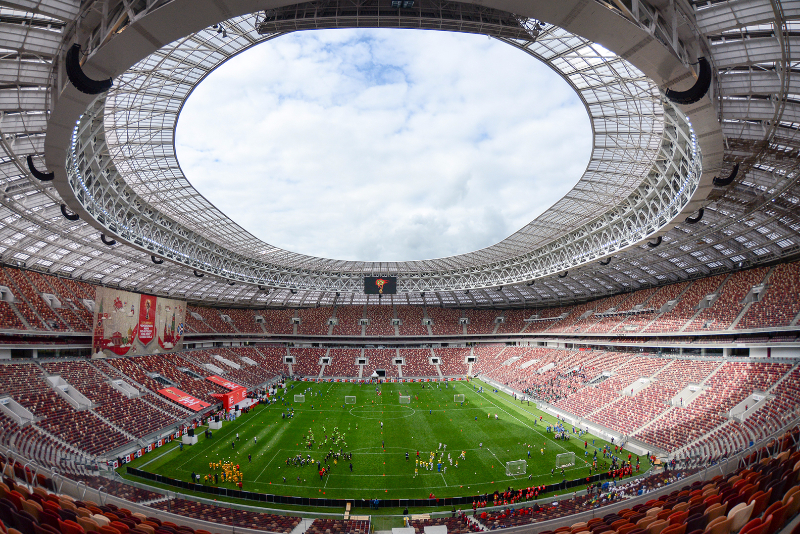Moscow 1980 & Sochi 2014; Two Renovated Olympic Stadiums used for the FIFA World Cup
Today the FIFA World Cup 2018 starts in Moscow. Two Olympic stadiums that have been renovated in recent years are used for the tournament.
Moscow 1980; Luzhniki Stadium

Olympic Games
During the 1980 Summer Olympics, the Central Lenin Stadium was the main venue which hosted the Opening and Closing Ceremonies, Athletics, Football finals, and the Individual Jumping Grand Prix. The stadium had at that time a spectator capacity of 103.000. (read more)
2018 FIFA World Cup
- Capacity: 81.000 Seats
- World Cup matches: 4 in the group stage, 1 round of 16, 1 semi-final, final
Sochi 2014; Fisht Olympic Stadium

Olympic Games
The Fisht Olympic Stadium in Sochi is converted into an open-air football stadium. Four years ago the stadium was used for the ceremonies of the Sochi 2014 Olympic and Paralympic Winter Games. The stadium then had a capacity of 40,000 seats.
2018 FIFA World Cup
- Capacity: 45,000 Seats
- World Cup matches: 4 in the group stage, 1 round of 16, 1 quarter-final
Barcelona 1992; Camp Nou (2)
The Barcelona 1992 Olympic Games are widely regarded as one of the most successful ever. Throughout 2017, 25 years later, we look back at the Games that forever changed Barcelona. (see all posts in this series)
Part 17 – Camp Nou
Camp Nou hosted part of the Barcelona 1992 Olympic football competition.
- 3 Group matches
- 2 Quarter-finals
- 1 Semi-final
- Bronze Medal match: Australia – Ghana 0-1 (Attendance 15,000)
- Gold Medal match: Poland – Spain (Attendance 95,000 – See video)
Location
Photos
Tokyo 2020; Kashima Stadium Approved as Football Venue
Today, the IOC Executive board approved the Kashima Stadium as football venue for Tokyo 2020.
Facts
- Capacity: 40,728 seats
- Opened: May 1993
- Expanded: 2001
- Tenants: Kashima Antlers
- Major events: 2002 FIFA World Cup
Location
Photos


Barcelona 1992; 25 Years later – Renovation Camp Nou
The Barcelona 1992 Olympic Games are widely regarded as one of the most successful ever. Throughout 2017, 25 years later, we look back at the Games that forever changed Barcelona. (see all posts in this series)
Part 3 – Renovation Camp Nou
A few months ago I visited Camp Nou. You can view the photos here.
Rio 2016; Mané Garrincha Stadium (Brasília)

MANÉ GARRINCHA STADIUM
- Location; Brasília
- Type; Existing
- Opened; 1974
- Architect; Ícaro de Castro Mello (1974) Castro Mello Arquitetos, gmp architekten, schlaich bergermann und partner (renovation 2013)
- Capacity; 72.778 seats
- Olympic Sports; Football (Group Matches: 8, Quarter-Finals: 2)
- Previous Events; 2013 FIFA Confederations Cup + 2014 FIFA World Cup
- Legacy; Home of Brasília FC and Legião FC





Barcelona 1992; Camp Nou

Camp Nou hosted part of the Barcelona 1992 Olympic football competition.
- 3 Group matches
- 2 Quarter-finals
- 1 Semi-final
- Bronze Medal match: Australia – Ghana 0-1 (Attendance 15,000)
- Gold Medal match: Poland – Spain (Attendance 95,000 – See video)



Rio 2016; Olympic venues in Google Maps (update 02-02-2016)
Update 02-02-2016: Small adjustments. Download kmz-file
I’ve created two maps in Google Earth with all Olympic venues in Rio de Janeiro and Brazil.
Rio 2016; FIFA confirms football stadiums
Map
- 58 Matches
- 3 to 20 August 2016
- Seven stadiums
- Six cities
- Belo Horizonte
- Brasilia
- Manaus
- Rio de Janeiro
- Salvador
- São Paulo
Read more: Olympic Football Tournaments to be played in six cities and seven stadiums [FIFA.com]
Football venues
Mineirão Stadium
- Belo Horizonte
- Constructed: 1965
- Capacity: 58.259
Mané Garrincha Stadium
- Brasilia
- Constructed: 2012
- Capacity: 69.432
Amazônia Arena
- Manaus
- Constructed: 2014
- Capacity: 41.000
Maracanã Stadium
- Rio de Janeiro
- Constructed: 1950
- Capacity: 74.689
Olympic Stadium
- Rio de Janeiro
- Constructed: 2007
- Capacity: 46.931
Fonte Nova Arena
- Salvador
- Constructed: 1951
- Capacity: 51.708
Corinthians Arena
- São Paulo
- Constructed: 2014
- Capacity: 61.606
Rio 2016; Brasilia National Stadium

Brasilia National Stadium
- gmp architekten
- Brasília
- 2013
The Estádio Nacional de Brasília is one of the stadiums which is going to be used for the Rio 2016 football tournament.
Architects’ description, drawings and photos on Archdaily



























